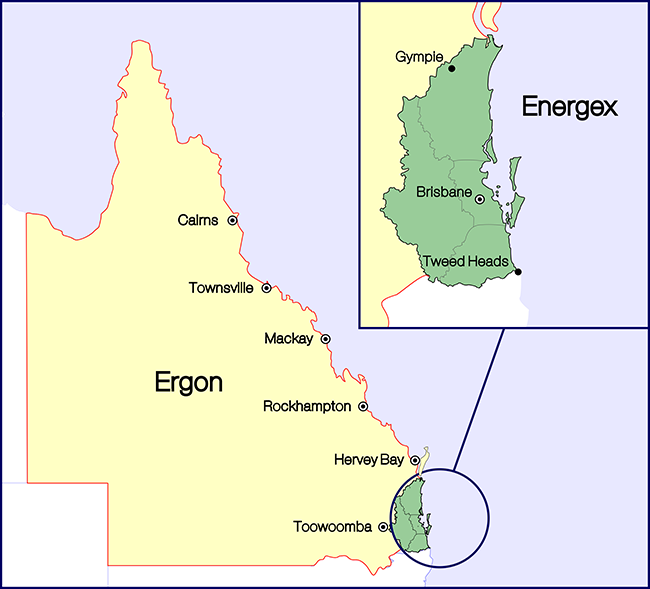QLD Solar Feed In Tariff Information
Last Updated: 2nd Sep 2025
In Queensland, the solar feed-in tariffs available vary by location. In the Energex network area in South East Queensland, you choose your retailer plan and associated feed-in tariff. In regional Australia, in the Ergon network area, there is far less retailer choice, and the large majority of homes have Ergon as their electricity retailer and use their feed-in tariff.

If you’re not sure which network area you’re in, it’s on your electricity bill.
South East Queensland – Energex
In the South East Energex area – which includes Brisbane, the Gold Coast, and the Sunshine Coast as far north as Noosa – solar feed-in tariffs are Voluntary Retailer Contributions. This means electricity retailers don’t have to pay anything for electricity solar energy households export to the grid, but they usually offer plans that do.
Below are three retailers offering plans that allow solar inverters of any size with above-average feed-in tariffs, as of September 2025:
- Red Energy: 5c/kWh
- Diamond: 3c/kWh
- Energy Australia: Solar Max plan gives 10c for first 12kWh exported per day, then drops to 4.6c.
If you have a solar inverter with a capacity of 10kW or less, some other options are:
- Engie: Engie Solar plan gives 10c for the first 8kWh exported per day, then drops to 3c.
- AGL: Solar Savers plan gives 8c for the first 10kWh exported per day, then drops to 3c.
- Alinta Energy: Solar Savers plan gives 10c for the first 10kWh exported per day, then drops to 4c.
Note that when an electricity retailer says they’ll pay a higher feed-in tariff for a set number of kWh per day, they don’t actually look at each individual day. They instead multiply the daily amount by the number of days in the billing cycle and give the higher rate for that amount. This is to your advantage, as the amount of solar electricity your home exports can vary considerably from day to day..
For the latest rates from these and other companies, try our electricity retailer comparison tool.
QLD electricity retailer plans with higher solar feed-in tariff rates won’t necessarily result in the lowest electricity bills for solar households. Plans with more generous solar feed-in tariffs aren’t always the cheapest overall – our comparison tool can help you find what might be the best deal for you.
Regional Queenslanders Are Usually With Ergon
In the regional Ergon network area, there’s little choice in electricity retailers. Energy Locals and Origin Energy offer plans in some locations, but as of September 2025, no Origin plan has a feed-in tariff in the Ergon area, so there’s no point in solar households using them.
Most homes in the Ergon area have Ergon as their retailer and receive a fixed feed-in tariff.
Due to factors ranging from an explosion and other problems at QLD’s Callide coal power station, as well as hikes in gas prices due to Russia invading Ukraine, feed-in tariffs were high over the past few years, but are now coming back down again. Here are Ergon’s feed-in rates over the past few years:
- 2021-22 6.583c/kWh
- 2022-23 9.3c/kWh
- 2023-24 13.411c/kWh
- 2024-25 12.377/kWh
For the 2025-26 financial year, the feed-in tariff rate has been set at 8.66 cents per kilowatt-hour. While a considerable drop, it’s still higher than the average received in South East Queensland.
Fill your roof! Years ago, the largest solar system regional Queenslanders could install and receive a solar feed-in tariff was 6.6kW. But this was changed in September 2017, so homes with large solar systems could receive a feed-in tariff. So if you want to install a large solar system, you can receive a feed-in tariff for all the solar energy you export. But note there are still plenty of places in remote Queensland where the amount you’ll be allowed to export will be limited due to local grid limitations. You’re solar installer will let you know if this is an issue. One work around is to install a battery.
Find Feed-In Tariffs And Compare Electricity Retailers
To find current solar FiT incentive rates offered by a wide variety of retailers in your part of Queensland, you can enter your postcode into this handy electricity retailer comparison tool.
Queensland’s Older And Higher Feed-In Tariffs
Queensland households and businesses that applied to install rooftop solar power systems before July 10, 2012 were eligible for the state’s Solar Bonus – a 44 cent feed-in tariff. Provided nothing is done to lose this high feed-in rate, it is locked in until July 1, 2028.
Keeping Your High Feed-In Tariff
In QLD, in order to maintain your high solar feed-in tariff rate, you have to stay where you are. If you move house, sell the home, rent it out, or change the name on the electricity account, you lose the high rate. The only exception is that it can be transferred between spouses if one moves out of the house.
You cannot increase your solar inverter size, but you can replace it with a same-sized or smaller one. You’re also unable to add extra solar panels in a situation where they will exceed the rated capacity of your system’s inverter
If you close your electricity account, you also lose your high FiT, and the same applies if you are disconnected. This means if you can’t pay your electricity bills because of financial difficulties, losing your high solar feed-in tariff can make paying future bills even more difficult.
For further rules and information about keeping your high feed-in tariff, see this page.
The easiest way to find a Queensland electricity retailer offering a good deal on FiT’s is to compare solar feed in tariffs using this tool.
